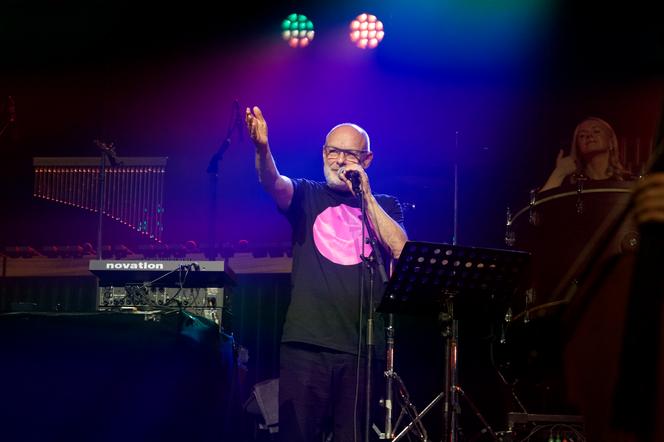


It's hard to imagine that this smooth-headed Englishman in his 70s was such an eye-catcher during his brief stint (1971-1973) with Roxy Music. It was the time of triumphant glam rock, and Brian Eno, behind his synthesizer, stole the show from singer Bryan Ferry, with his long hair, made-up eyes, furs and feathers. After his departure, the short-lived rock star became a fascinating explorer of sound, with a complete absence of commercial consideration, besides for his musical clients.
Although the general public may be familiar with Eno's name, it's usually thanks to his many collaborations as producer and composer, for David Bowie (the so-called "Berlin trilogy"), Talking Heads, U2 at its best (the albums The Joshua Tree, in 1987, and Achtung Baby, in 1991) or Coldplay, among others.
To say the least, Brian Eno's stage appearances have been few and far between. The concert he gave at La Seine Musicale, Boulogne-Billancourt (west of Paris), on Thursday, October 26, was his first in France since... 1975, when he came to the Paris Olympia in the company of guitarist Robert Fripp, the mastermind of King Crimson. He may have made a few scattered appearances, but he hadn't embarked on a tour since Roxy Music. This belated excursion includes only a handful of dates at venues such as La Fenice in Venice and the Berlin Philharmonic. Places where art music is played.
The artist who kept the audience waiting, enveloped in Zen-like softness, reminded us of what we owe him. With his series of four albums, starting with Music for Airports in 1978, Eno is credited as the inventor of ambient music, a genre that was destined to become a category of electro, even if its origins go back to the "furniture music" conceptualized by Erik Satie as early as 1917. The short set (80 minutes) was not in this vein, as the musician was seized by the urge to sing. This would appear to be his Achilles' heel, despite the technical manipulations and the support of soprano Melanie Pappenheim. To kick things off, there were four tracks from The Ship (2016), a modern allegory based on the sinking of the Titanic.
To (re)discover it, Eno employed a young orchestra, the Baltic Sea Philharmonic, conducted by Kristjan Järvi. The instrumentalists entered one by one, taking center stage and moving freely with their conductor. There is no score for this work composed by a "non-musician," as Eno defines himself. The work focuses on timbres, flat tones and volume when the brass rumbles. In the end, a melody emerged, but it was Lou Reed who was responsible for it, with a cover of "I'm Set Free" (1969) by The Velvet Underground. Respectful, if not enthusiastic, applause followed.
You have 20% of this article left to read. The rest is for subscribers only.
